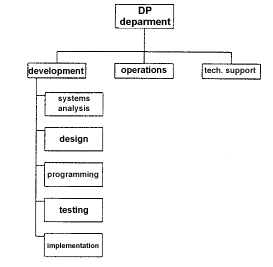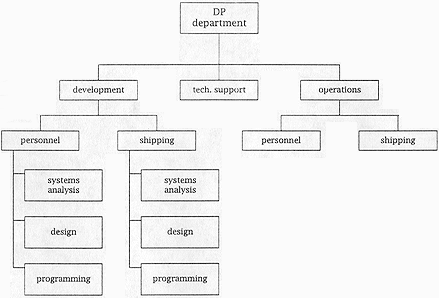| 3. | (a) Briefly outline four general
principles that should be considered in determining the structure of a data processing
department. |
[6] |
General
principles in determining the structure:
one mark for each principle identified, to a maximum of four marks
|
||
| (b) The diagram below shows a basic
organisation for a data processing department:
This structure is usually appropriate for small to
medium-sized data processing functions. In the following two situations, a different
organisation might be employed. |
||
(i) The data processing department at ABC Consultants is tasked with developing a large number of very different applications. Each application must be developed according to the same guidelines, to meet the same company standards. Often, the applications will need to communicate with each other. Suggest a suitable organisation for the data processing department at ABC Consultants, and illustrate your answer with a diagram. |
[4] | |
| A
suitable organisation for ABC consultants might be the functional organisation (1 mark);
application organisation is less suitable as common standards (1 mark) and
interoperability required (1 mark); no information regarding application areas (1 mark) up
to three marks for this explanation; one mark for the diagram |
||
(ii) The data
processing department at DEF products, an import-export company, handles two kinds of
application: payroll and employee record packages for the personnel department; stock
control and ordering packages for the warehousing and shipping department. Suggest a
suitable organisation for the data processing department at DEF products, and illustrate
your answer with a diagram. |
[4] | |
| A
suitable organisation for DEF products might be the applications organisation (1 mark),
with a separate unit for each type of application (1 mark), allowing teams to specialise
in application areas (1 mark), the areas are quite different, and communication between
different types of application would probably be quite limited (1 mark) up to three marks for this explanation; one mark for the diagram
|
||
| (c) If data processing is an
integral part of company operations, then an independent department may be established,
directly under the control of the head of the company. Where this is not the case, we may
find that data processing is located either in a service department, or in
several different user departments. Compare and contrast these two approaches to locating data processing activities. Take care to explain the advantages and disadvantages of each approach. |
[8] | |
|

